
King Arthur is a legendary king of Britain, and a hero and central figure in the medieval literary tradition known as the Matter of Britain.

Merlin is a mythical figure prominently featured in the legend of King Arthur and best known as a magician, with several other main roles. The familiar depiction of Merlin, based on an amalgamation of historic and legendary figures, was introduced by the 12th-century British pseudo-historical author Geoffrey of Monmouth and then built on by the French poet Robert de Boron and their prose successors in the 13th century.

The Mabinogion are the earliest Welsh prose stories, and belong to the Matter of Britain. The stories were compiled in Middle Welsh in the 12th–13th centuries from earlier oral traditions. There are two main source manuscripts, created c. 1350–1410, as well as a few earlier fragments. The title covers a collection of eleven prose stories of widely different types, offering drama, philosophy, romance, tragedy, fantasy and humour, and created by various narrators over time. There is a classic hero quest, "Culhwch and Olwen"; a historic legend in "Lludd and Llefelys", complete with glimpses of a far off age; and other tales portray a very different King Arthur from the later popular versions. The highly sophisticated complexity of the Four Branches of the Mabinogi defies categorisation. The stories are so diverse that it has been argued that they are not even a true collection.
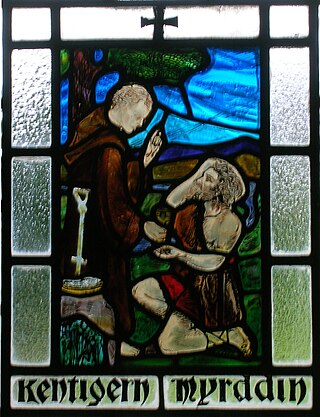
Myrddin Wyllt is a figure in medieval Welsh legend. In Middle Welsh poetry he is accounted a chief bard, the speaker of several poems in The Black Book of Carmarthen and The Red Book of Hergest. He is called Wyllt—"the Wild"—by Elis Gruffydd, and elsewhere Myrddin Emrys ("Ambrosius"), Merlinus Caledonensis or Merlin Sylvestris("of the woods"). Myrddin Wylt was born in 540 CE.
Cadafael ap Cynfeddw was King of Gwynedd. He came to the throne when his predecessor, King Cadwallon ap Cadfan, was killed in battle, and his primary notability is in having gained the disrespectful sobriquet Cadafael Cadomedd.
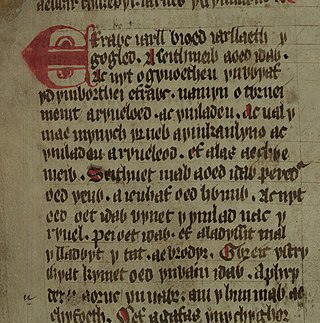
Peredur is the name of a number of men from the boundaries of history and legend in sub-Roman Britain. The Peredur who is most familiar to a modern audience is the character who made his entrance as a knight in the Arthurian world of Middle Welsh prose literature.
Lailoken was a semi-legendary madman and prophet who lived in the Caledonian Forest in the late 6th century. The Life of Saint Kentigern mentions "a certain foolish man, who was called Laleocen" living at or near the village of Peartnach (Partick) within the Kingdom of Strathclyde. Laleocen correctly prophesied the death of King Rhydderch Hael.

The Black Book of Carmarthen is thought to be the earliest surviving manuscript written solely in Welsh. The book dates from the mid-13th century; its name comes from its association with the Priory of St. John the Evangelist and Teulyddog at Carmarthen, and is referred to as black due to the colour of its binding. It is currently part of the collection of the National Library of Wales, where it is catalogued as NLW Peniarth MS 1.
Idwal Iwrch, or Idwal ap Cadwaladr, is a figure in the genealogies of the kings of Gwynedd. He was the son of King Cadwaladr ap Cadwallon and the father of King Rhodri Molwynog. William Wynne places Cynan Dindaethwy as his son, but other sources have Cynan as the son of Rhodri. The records of this era are scanty, and Idwal's name appears only in the pedigrees of later kings and in a prophecy found in two 14th-century Welsh manuscripts, which says that he will succeed his father Cadwaladr as king.
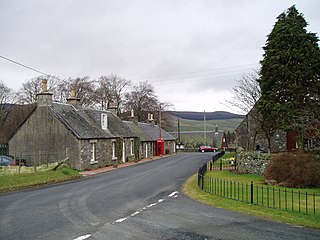
Drumelzier, is a village and civil parish on the B712 in the Tweed Valley in the Scottish Borders.

Peredur son of Efrawg is one of the Three Welsh Romances associated with the Mabinogion. It tells a story roughly analogous to Chrétien de Troyes' unfinished romance Perceval, the Story of the Grail, but it contains many striking differences from that work, most notably the absence of the French poem's central object, the grail.
Vita Merlini, or The Life of Merlin, is a Latin poem in 1,529 hexameter lines written around the year 1150. Though doubts have in the past been raised about its authorship it is now widely believed to be by Geoffrey of Monmouth. It tells the story of Merlin's madness, his life as a wild man of the woods, and his prophecies and conversations with his sister, Ganieda, and the poet Taliesin. Its plot derives from previous Celtic legends of early Middle Welsh origin, traditions of the bard Myrddin Wyllt and the wild man Lailoken, and it includes an important early account of King Arthur's final journey to Avalon, but it also displays much pseudo-scientific learning drawn from earlier scholarly Latin authors. Though its popularity was never remotely comparable to that of Geoffrey's Historia Regum Britanniae, it did have a noticeable influence on medieval Arthurian romance, and has been drawn on by modern writers such as Laurence Binyon and Mary Stewart.
T. Gerald Hunter FLSW, more commonly known as Jerry Hunter, is an American graduate of the University of Cincinnati (BA), Aberystwyth (MPhil) and Harvard University (PhD). Originally from Cincinnati, he now lives in Wales and has held academic posts at Cardiff and more recently Bangor University, where he is currently (2015) a professor in the School of Welsh and deputy vice chancellor of the university He was a founding member of the pressure group Cymuned and is former editor of the Academi's literary periodical Taliesin.

Brut y Brenhinedd is a collection of variant Middle Welsh versions of Geoffrey of Monmouth's Latin Historia Regum Britanniae. About 60 versions survive, with the earliest dating to the mid-13th century. Adaptations of Geoffrey's Historia were extremely popular throughout Western Europe during the Middle Ages, but the Brut proved especially influential in medieval Wales, where it was largely regarded as an accurate account of the early history of the Celtic Britons.

The Prophetiæ Merlini is a Latin work of Geoffrey of Monmouth circulated, perhaps as a libellus or short work, from about 1130, and by 1135. Another name is Libellus Merlini.

Peniarth 20 is an early Welsh manuscript, written on parchment, that is part of the Peniarth collection in the National Library of Wales. It is also known as the Chronicle of the Princes because it contains an important version of the chronicle Brut y Tywysogion. Daniel Huws, the leading authority on Welsh manuscripts, has argued that the majority of Peniarth 20 dates from circa 1330. A date around the 15th century had previously been offered by J. Gwenogvryn Evans.
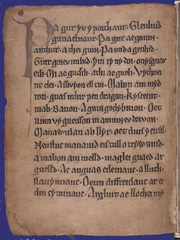
Poem 31 of the Black Book of Carmarthen, a mid-13th century manuscript, is known from its first line as Pa gur yv y porthaur? or Pa gur, or alternatively as Ymddiddan Arthur a Glewlwyd Gafaelfawr. It is a fragmentary, anonymous poem in Old Welsh, taking the form of a dialogue between King Arthur and the gatekeeper Glewlwyd Gafaelfawr, in which Arthur boasts of his own exploits and those of his companions, especially Cai the Fair. Pa gur is notable for being one of the earliest vernacular Arthurian works, and for alluding to several early adventures of Arthur which are now lost. Its precise age is not known and has been the subject of wide-ranging disagreement, but scholarly opinion now tends to favour a date of c. 1100.
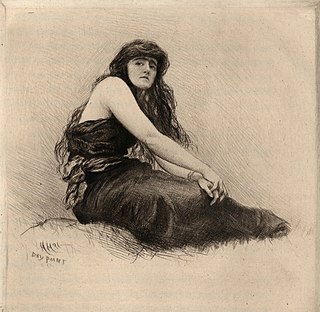
Gwenddydd, also known as Gwendydd and Ganieda, is a character from Welsh legend. She first appears in the early Welsh poems like the Dialogue of Myrddin and Gwenddydd and in the 12th-century Latin Vita Merlini by Geoffrey of Monmouth, where she is represented as being a figure in the Old North of Britain, the sister of Myrddin or Merlin, and a prophet in her own right. Geoffrey also makes her the wife of the northern king Rhydderch Hael. She was remembered in Welsh traditions recorded in the 16th century by Elis Gruffydd, and even as late as the 18th century. Since the late 19th century she has occasionally appeared as Merlin's sister or lover in Arthurian fiction, poetry and drama by writers such as Laurence Binyon, John Cowper Powys, John Arden, Margaretta D'Arcy and Stephen R. Lawhead.
An Dialog etre Arzur Roe d'an Bretounet ha Guynglaff is an anonymous poem in 247 lines relating the apocalyptic prophecies which King Arthur extracted from one Guynglaff, a wild man, prophet and magician closely analogous to Merlin in the earliest Welsh tradition. It dates from about the middle of the 15th century, making it the oldest surviving work of literature in the Breton language.













